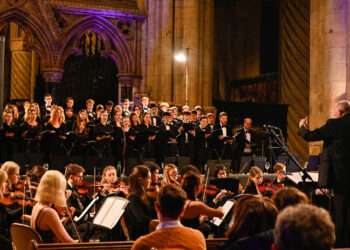One of the most delightful facts I know about Haydn is that in 1792, he paid a visit to Sir William Herschel and had a peek at the universe through his host’s very large telescope – a truly gigantic instrument for its age, and which was for a long time, the biggest telescope in the world. It’s been suggested that the staggering view of the Milky Way inspired Haydn to create some of the cosmic grandeur that we hear in Creation and although there is no substance to this, it’s a nice thought. The swirling depiction of chaos and the awe-inspiring appearances of sun and moon weren’t Haydn’s first trip to the heavens though. I don’t think I have ever written the words “sci-fi comic opera” before, but that’s what Haydn created when he wrote Il Mondo della Luna, a work that English Touring Opera are bringing in a new production to Gala Durham in November under their English title Life on the Moon.
First of all, let’s get past the “I didn’t know that Haydn wrote any operas at all, let alone sci-fi comic opera” – I had totally forgotten as well, although I think I did know once, and it’s true that they are largely overlooked – Haydn did more significant things and there were more significant operas being written by other people. Furthermore, most of his operas were written for performance at the Esterháza summer palace, the magnificent residence of Haydn’s long term employers, and so the fact that they were never intended for public performance may partially explain their subsequent neglect. He did write one final opera later, in London – his addition to the long list of Orpheus settings, but it was never performed.
A few of Haydn’s Esterháza operas treat the high classical subjects that would have been familiar in his eighteenth-century world – Armida, Acis and Galatea, Orlando, but many more of them are comic dramas, sometimes with spoken dialogue, and using original, contemporary libretti such as Il Mondo della Luna. This was the third of his settings of texts by the Italian playwright Carlo Goldoni and the plot couldn’t be further from the high tragedies of the baroque world. English Touring Opera are performing in English, in a new translation, and the director is Cal McCrystal, who created the physical comedy scenes in the National Theatre’s very successful production of One Man Two Guv’nors – which is in fact an adaptation of another Goldoni play. So all in all, the signs are that this is going to be a lot of fun.

The plot is straightforwardly silly and judging by ETO’s cast list and running time, it looks as if it’s been streamlined quite considerably by omitting the two serious characters Ernesto and Flaminia. The opera opens with the astronomer Ecclitico boasting about how, by using silhouettes on his telescope lens, he can fool people into thinking that they’re seeing daily life on the moon. Buonafede, a rich old man, is suitably impressed when he looks through the telescope and thinks he is seeing a world that really appeals to him – old men embracing young girls, and men ruling over their women. Ecclitico is in love with Buonafede’s daughter Clarice, but the old man is holding out for a richer suitor, and so Ecclitico comes up with an even greater fraud – he will trick Buonafede into believing that he has actually flown to the moon. With the help of Clarice and two servants, and a “magic potion” they transform Buonafede’s garden into “the Moon”. The pranksters go through various charades to fool Buonafede, ending with the supposed inhabitants of the moon getting him to give his consent to the marriage of Clarice and Ecclitico.
The music is typical Haydn, light, airy and full of character. There are some glorious arias, boisterous duets and ensembles, and the moon scenes are laden with atmospheric wind writing and string harmonics. For a taster though, try this lovely recording session video of Patricia Petibon singing the coloratura aria Ragion nell’ama siede
And if you can’t make it to the Gala, here’s a full length film version:
http://www.youtube.com/watch?v=N7kuLJo_DT4








